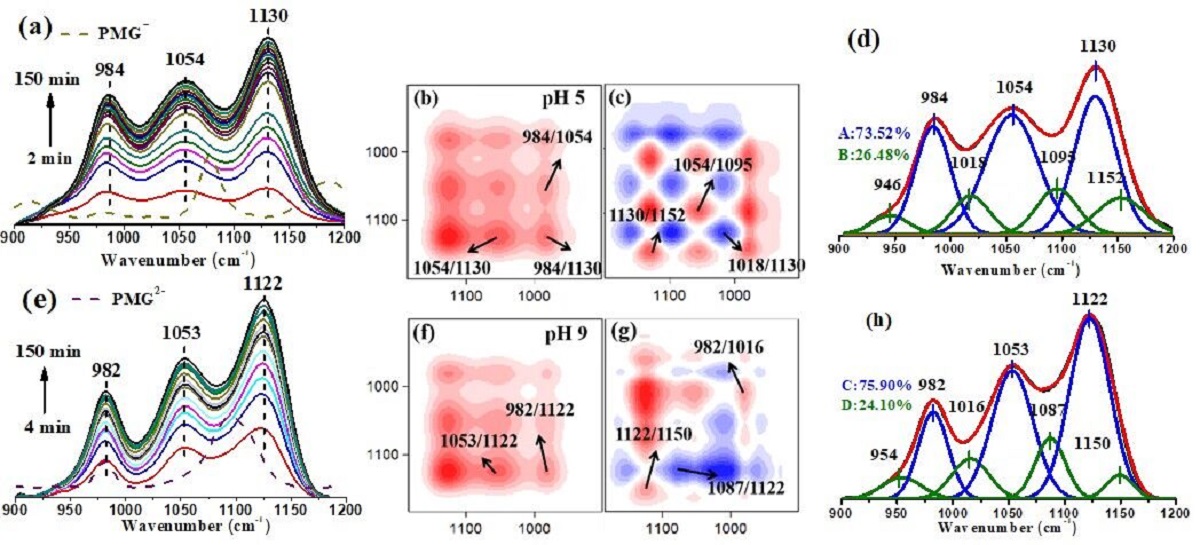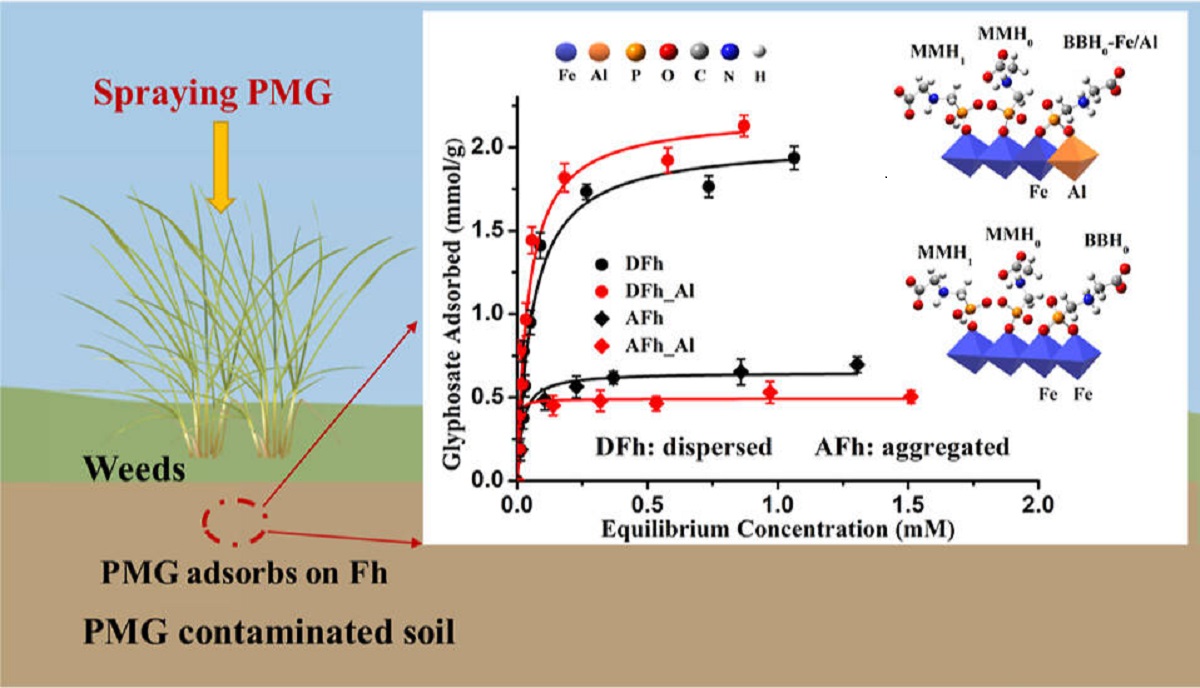南湖新闻网讯(通讯员 刘哲)近日,我校资源与环境学院土壤矿物与环境团队在有机磷除草剂的界面分子吸附机制方面取得新进展,相关成果以“Adsorption Mechanisms of Glyphosate on Ferrihydrite: Effects of Al Substitution and Aggregation State”为题发表于Environmental Science & Technology期刊。
研究通过宏观批量吸附实验、同步辐射光谱、原位红外光谱结合二维相关光谱、分峰拟合和多元曲线分辨等现代分析技术,定量揭示了草甘膦在水铁矿表面的分子吸附形态,系统阐明了水铁矿聚集形态和Al同晶替代效应,从分子水平提升了土壤氧化铁与有机磷污染物的界面互作机制认识,为评估和预测环境中草甘膦的迁移—转化行为和环境风险提供了科学依据,对土壤农药污染修复和土壤可持续利用有重要意义。
草甘膦是世界范围使用最广泛的有机磷类除草剂,然而草甘膦植物利用率低、半衰期长,易在土壤中残留或流失进入水体,抑制生物体内酶活和蛋白质合成,对环境生物和人体健康具有潜在毒性及致癌风险。草甘膦在土壤矿物界面的吸附决定其迁移性、环境毒性和生物有效性。在常见环境pH条件下,草甘膦带负电,容易被带正电的铁铝氧化物表面强烈吸附,形成内圈络合物,显著减小其迁移性和有效性。与其它土壤矿物相比,弱结晶水铁矿因其比表面积大、位点密度高、反应活性高等特点,表现出更强的草甘膦吸附能力。水铁矿在土壤中广泛存在,且因含水量不同呈现出不同的聚集状态,从而影响其反应活性。此外,天然水铁矿结构中Al同晶替代普遍存在,Al替代可以增加矿物结构缺陷和表面正电荷及影响表面OH位点的分布和数量。然而,Al替代和聚集程度对水铁矿吸附草甘膦的影响规律和相关吸附分子机制尚不明晰。
基于此,本研究合成了聚集型和分散型(Al替代)水铁矿,并表征其结构和表面特性;通过吸附等温线、pH边和Zeta电位揭示聚集程度和Al替代对水铁矿表面吸附草甘膦的影响;利用P(磷)K边X射线近边吸收光谱(XANES)、原位红外(ATR-FTIR)结合二维相关光谱(2D-COS)和多元曲线分辨最小二乘法(MCR-ALS)、量化计算(DFT)等分析技术,定量阐明了草甘膦在(Al替代)水铁矿表面的吸附位点和构型。研究表明,水铁矿聚集显著降低了草甘膦的吸附能力。Al替代使聚集型水铁矿的外比表面积减小,抑制了草甘膦的吸附;但Al替代增加了分散型水铁矿的表面正电荷,从而促进了草甘膦吸附。草甘膦在水铁矿表面主要形成质子化或非质子化单齿单核络合物(MMH1/MMH0, 77 - 90%),并含少量非质子化双齿双核络合物(BBH0, 23 - 10%)。Al替代和低pH均有利于草甘膦双齿双核络合物的形成。在吸附过程中,草甘膦优先在水铁矿表面形成单齿单核络合物,并优先与Al替代水铁矿表面的Al-OH位点结合。

图1 草甘膦在水铁矿表面吸附的原位红外光谱及其二维相关光谱和分峰拟合分析

图2 草甘膦在水铁矿表面的吸附行为和机制示意图
我校资源与环境学院2023届硕士研究生黎学文为论文第一作者,王小明副教授为论文通讯作者。美国阿贡国家实验室杨鹏博士,特拉华大学Deb P. Jaisi副教授,华中农业大学冯雄汉教授、谭文峰教授、马红菊副教授、郭发扬博士、研究生赵万通、宓少为、林冰等参与了部分研究。本研究得到国家现代农业产业体系(CARS26)、国家自然科学基金(41977021、42030709)和国家重点研发计划的资助(2020YFC1806803)。
英文摘要: Ferrihydrite is one of the most reactive iron (Fe) (oxyhydr)oxides in soils, but the adsorption mechanisms of glyphosate, the most widely used herbicide, on ferrihydrite remain unknown. Here, we determined the adsorption mechanisms of glyphosate on pristine and Al-substituted ferrihydrites with aggregated and dispersed states using macroscopic adsorption experiments, zeta potential, phosphorus K-edge X-ray absorption near-edge structure spectroscopy, in situ attenuated total reflectance Fourier transform infrared spectroscopy coupled with two-dimensional correlation spectroscopy, and multivariate curve resolution analyses. Aggregation of ferrihydrite decreases the glyphosate adsorption capacity. The partial substitution of Al in ferrihydrite inhibits glyphosate adsorption on aggregated ferrihydrite due to the decrease of external specific surface area, while it promotes glyphosate adsorption on dispersed ferrihydrite, which is ascribed to the increase of surface positive charge. Glyphosate predominately forms protonated and deprotonated, depending on the sorption pH, monodentate−mononuclear complexes (MMH1/MMH0, 77−90%) on ferrihydrites, besides minor deprotonated bidentate−binuclear complexes (BBH0, 23−10%). Both Al incorporation and a low pH favor the formation of the BB complex. The adsorbed glyphosate preferentially forms the MM complex on ferrihydrite and preferentially bonds with the Al−OH sites on Al-substituted ferrihydrite. These new insights are expected to be useful in predicting the environmental fate of glyphosate in ferrihydrite-rich environments.
审核人:王小明